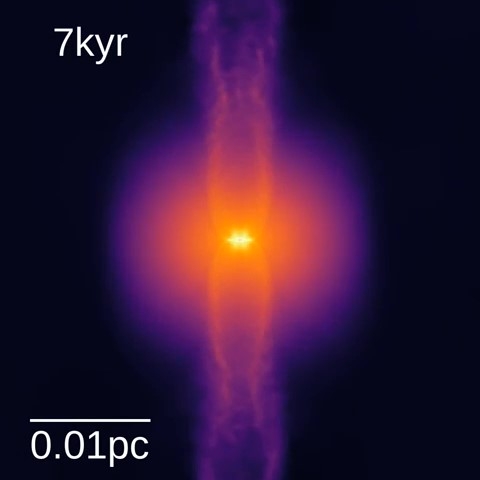STARFORGE: a Spectacular Simulation of Stars Being Born
Thanks to the Star Formation in Gaseous Environments algorithm (STARFORGE), we can view an unprecedentedly detailed simulation of the process of star formation.
As mentioned in a previous article, understanding how stars are born from huge interstellar clouds of gas and dust is a very tricky matter. Stages like an interstellar cloud before its gravitational collapse, “yellowballs” or protostars can all be observed, yet it takes millions of years for the whole star-production process to complete, so astrophysicists’ hope is to accurately model the physical effects involved. Such a visualization has been achieved with STARFORGE, with which three major challenges in modelling star formation are addressed: first, within one Giant Molecular Cloud a large number of stars are formed, which means simulations need to have the right resolution – down to 10–100 Astronomical Units (1 AU is the distance from the Earth to the Sun) - if one wants to follow the developments leading to individual stars.
However, this requires a lot of computational power, so that previous models have only simulated a fraction of a molecular cloud. Hence the second problem that the STARFORGE team tackled is the scale of the model; their publication mentions whole clouds over 105 solar masses, a typical cloud mass although the heaviest ones can reach masses more than 100 times that. The team’s most precise simulation for that scale ran for over 70 days at one of the world’s most powerful supercomputers at the Texas Advanced Computing Center – the time taken by each of the computer’s individual “cores” actually sums up to a mind-blowing 4.8 million hours!

Now videos of these simulations have been released, including one showing the details of a single protostar and its jets. This relates to the third difficulty for an accurately modelling of star formation, the so-called feedback effects. These are events like jets, stellar winds, nearby supernovae and more, which had never been simultaneously included in a simulation before on top of the common factors like gravity, magnetic fields and gas dynamics. Both their first simulation of a 20 000 solar masses cloud, “The Anvil of Creation”, which came out a few months ago, and the more recent video of star formation in a 200 000 solar masses cloud, suggest that feedback effects are much more significant than previously thought. Notably, simulations without jets lead to stars with very high masses, while when jets are present stars gain average masses. This seemingly obvious effect that jets blow away gas that could have ended up in the star, reducing its mass, in fact couldn’t be established that precisely before.
The dependence of the star’s mass on feedback effects during its formation was previously greatly underestimated, but thanks to the STARFORGE project, we are getting a better (and stunning) view of what happens over the few million years during which a giant molecular cloud turns into a collection of stars. You can find all the team's videos on their webiste.
All Image credit to: STARFORGE/Northwestern University/UT Austin
